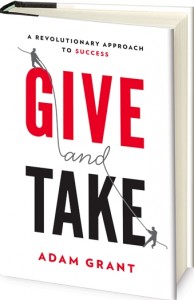 I am currently reading “Give And Take – A Revolutionary Approach To Success” by Adam Grant. I was not familiar with the book or the author but Give and Take came highly recommended by Jeremey Donovan who wrote “How To Give A TED Talk” that I reviewed earlier this year.
I am currently reading “Give And Take – A Revolutionary Approach To Success” by Adam Grant. I was not familiar with the book or the author but Give and Take came highly recommended by Jeremey Donovan who wrote “How To Give A TED Talk” that I reviewed earlier this year.
Rarely do I read a book in which I am not familiar with the author or the content. In the case of Give and Take, I’m glad I did. Grant has taken a very unique look at the difference between givers and takers and how different paths lead to different results.
This will be the first of three posts in which I will briefly summarize each of the nine chapters. Grant suggests that most people fall into one of two categories; givers and takers. Matchers are the in-between group and operate on the principal of fairness and strive to preserve an equal balance of giving and getting.
GOOD RETURNS – The Dangers and Rewards of Giving More Than You Get
In the first chapter Grant lays out the basic differences between givers and takers and sets up the entire concept with this:
“According to conventional wisdom, highly successful people have three things in common: motivation, ability and opportunity. If we want to succeed, we need a combination of hard work, talent, and luck.” Then he offers up the fourth ingredient – “success depends heavily on how we approach our interactions with other people.”
He goes on to define givers and takers but really get’s you hooked when he explains that it is givers who sit at both the bottom and the top of the success ladder. Only a third of the way into the book, this one is already hitting home. Givers do start out at the bottom, but there is a clear path to success that Grant spells out.
THE PEACOCK AND THE PANDA – How Givers, Takers, and Matchers Build Networks
In chapter two, Grant takes a look at how givers, takers, and matchers develop fundamentally distinct networks, and why their interactions within these networks have different characters and consequences.
Grant explores the idea that networks come with three major advantages: private information, diverse skills, and power. “By developing a strong network, people can gain invaluable access to knowledge, expertise, and influence.” Do those sound like important elements to success?
THE RIPPLE EFFECT – Collaboration and the Dynamics of Giving and Taking Credit
In chapter three we find Grant exploring how the differences between givers and takers affect individual and group success. Grant tells a few stories about some of the great influencers of our past and draws this conclusion:
“Americans see independence as a symbol of strength, viewing interdependence as a sign of weakness. This is particularly true of takers, who tend to see themselves as superior to and separate from others.”
“Givers reject the notion that interdependence is weak. Givers are more likely to see interdependence as a source of strength, a way to harness the skills of multiple people for a greater good.”
This book has pushed me to really take a hard look at my motives and actions regarding giving and taking and I think that there are two types of giving that we need to focus on. Grant suggests that if you have the opportunity to give to someone else and it will take five minutes or less – just do it. I have found that most of this type of giving falls into the “random acts of kindness” category.
The second type of giving is more strategic and planned out but still falls into the giving category. We all need to create and income to survive and I believe that to be successful, you need a strategy. There is nothing wrong with doing something “free of charge” or “paying it forward” as they say, but you can do these things with an end goal in sight.
So you probably already know the question for today; “Are you a Giver or a Taker?” If you are not sure, or want to see what Grant thinks, click here and take The Give And Take Assessment.
***********************************************************************
Don’t miss a single post from Building What Matters by subscribing at the top left of this page.
Help support us by clicking here and Liking our facebook page
Barry Smith 8/7/13 photo courtesy of Amazon © Building What Matters 2013


I taught for 30 years K~5th grade. I taught my students you need to be both. Their are times to give and other times you are taking. Anytime you are way more of one…you will have problems. I taught about giving and taking for years! I would love to read your book! Great topic!!!
Thanks Jeanne. Sounds like you were a great teacher. Thanks for investing 30 years in the positive development of our youth.